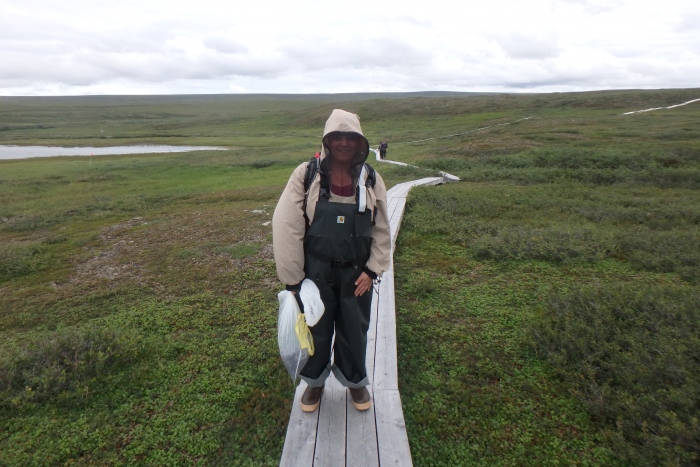The PolarTREC Field Experience
PolarTREC has been an incredible experience for me, both professionally and personally. The expedition and experience have shifted the way I teach about science in the field and how I approach this with the students. It has also reiterated the fact that I am educating my students to think critically and ask testable questions. This experience was an incredible opportunity to practice what I teach and to experience first hand the scientific process. I would strongly encourage a fellow educator to go on a scientific expedition and have the experience to share back in the classroom.
The Importance of Teacher/Researcher Collaboration
I feel incredibly lucky to have been selected by Dr. Bret-Harte. She is brilliant and an established researcher in the Arctic. Collaborating with her was an incredible experience and one that she and I plan to continue long after the expedition. The work that is being done in the Arctic needs to be articulated so the general public can understand its importance.
 Dr. Bret-Harte in the field placing the flag markers on the quadrats in the Tussock Snowfence Study
Dr. Bret-Harte in the field placing the flag markers on the quadrats in the Tussock Snowfence Study
Dr. Bret-Harte and I both brought our own experiences to this expedition and worked well together.
I am so grateful that Dr. Bret-Harte wanted an educator in the field. Like having a student teacher, having someone working with you can be taxing and sometimes a lot of extra work. But like the student teacher, the experience encourages growth for everyone involved. Dr. Bret-Harte shared her knowledge with me and I shared with her. By opening up the classroom/field to others, it only grows you as a professional. Dr. Bret-Harte sprained her ankle halfway through the expedition and I stepped up as the lead in the collection of the plots. I was responsible for leading the team up the site and made sure that the plots were collected accurately. This was a benefit to her, having someone who although I didn’t have all of the background knowledge she has, was able to be a quick study and understood enough to know about the precision and accuracy that was needed for this step in the process. This experience benefited me as well in that this is what I teach my students and I was living it in the field, practicing what I preach.
Summary of the Science, or The Science Explained
Shrubs, Snow, and Nitrogen in the Arctic is a project that Dr. Bret-Harte initiated in 2006. As a scientist, she noticed that there was a shift in the vegetation in the tundra and starting researching the different deciduous shrubs to predict the consequences of their expansion in the Arctic. In 2006, Dr. Bret-Harte established her field sites and snow fences and injected the earth with one extra proton in Nitrogen, or 15N. But what does that mean? Atomically, Nitrogen has 14 protons. By adding one extra proton, Dr. Bret-Harte will be able to follow the cycle of Nitrogen throughout the plants in the plots. Why would this be important? The Arctic tundra is Nitrogen-deficient and with the warming temperatures, some of the plants, her hypothesis is the deciduous shrubs, are increasing their Nitrogen intake and taking over from the smaller native species. Our work in 2018 consisted of harvesting the 48 plots and “plucking” the different species of plants so that they could be viewed under a mass spectrometer.
 The bag of earth in the lab ready for the pluck.
The bag of earth in the lab ready for the pluck.
Linking PolarTREC to my Classroom/Audience/Institution and Community
Living in the Sonoran Desert, the Arctic seems like the polar opposite (pun intended) side of the world. In many ways, however, the two are very much connected. Both locations are deserts and receive very little precipitation. The Arctic tundra is Nitrogen-deficient. The Sonoran Desert is water deficient. The ecosystems are also similar in that the plant species that dwell in the locations have to be very well adapted to the biome. These connections linked my community and school to the work that I was doing in the Arctic.
Bringing the Science Back to my Classroom/Audience/Institution and Community
The work I did in the Arctic is very difficult to replicate, but what I was able to do was bring back samples of mosses and liverworts and the students were able to see the plants up close and personal.
 Svea Anderson carries a bag containing a cut quadrat sample along the boardwalk. Toolik Field Station, Alaska. Photo by Donie Bret-Harte
Svea Anderson carries a bag containing a cut quadrat sample along the boardwalk. Toolik Field Station, Alaska. Photo by Donie Bret-Harte
The other, probably most important aspect of the work I did there, was bringing back what real science looks like. The students saw me taking chances, read about the mistakes I made in the field, and what I learned from them, saw on Skype the relationship I have with Dr. Bret-Harte, and how we were able to communicate her research into a language that they could understand. Through their questions on my blog, they were critically thinking about the work, as well as my daily living experiences which are important to students who are 11 and 12.
Further Education and Outreach Opportunities
Within a week of returning, I presented at the Arizona Sonora Desert Museum and their Teacher Appreciation Night. I have also presented at the annual Arizona Science Teachers Association meeting, written for an online journal, and have shared my story with my school board and the Arizona Department of Education.
 Svea Anderson stands in front of the Toolik Field Sign on her last night at the field site. Photo by Donie Bret-Harte
Svea Anderson stands in front of the Toolik Field Sign on her last night at the field site. Photo by Donie Bret-Harte| Attachment | Size |
|---|---|
| Download Report2.32 MB | 2.32 MB |
